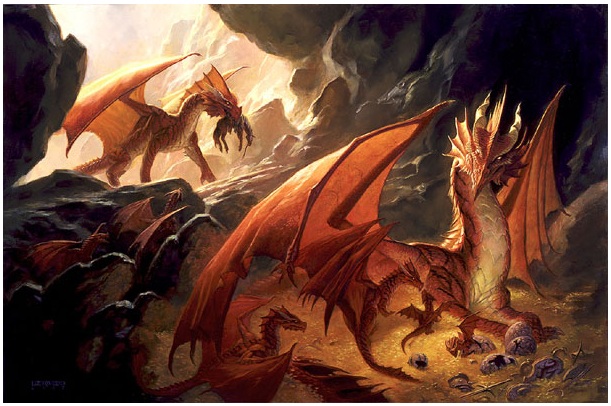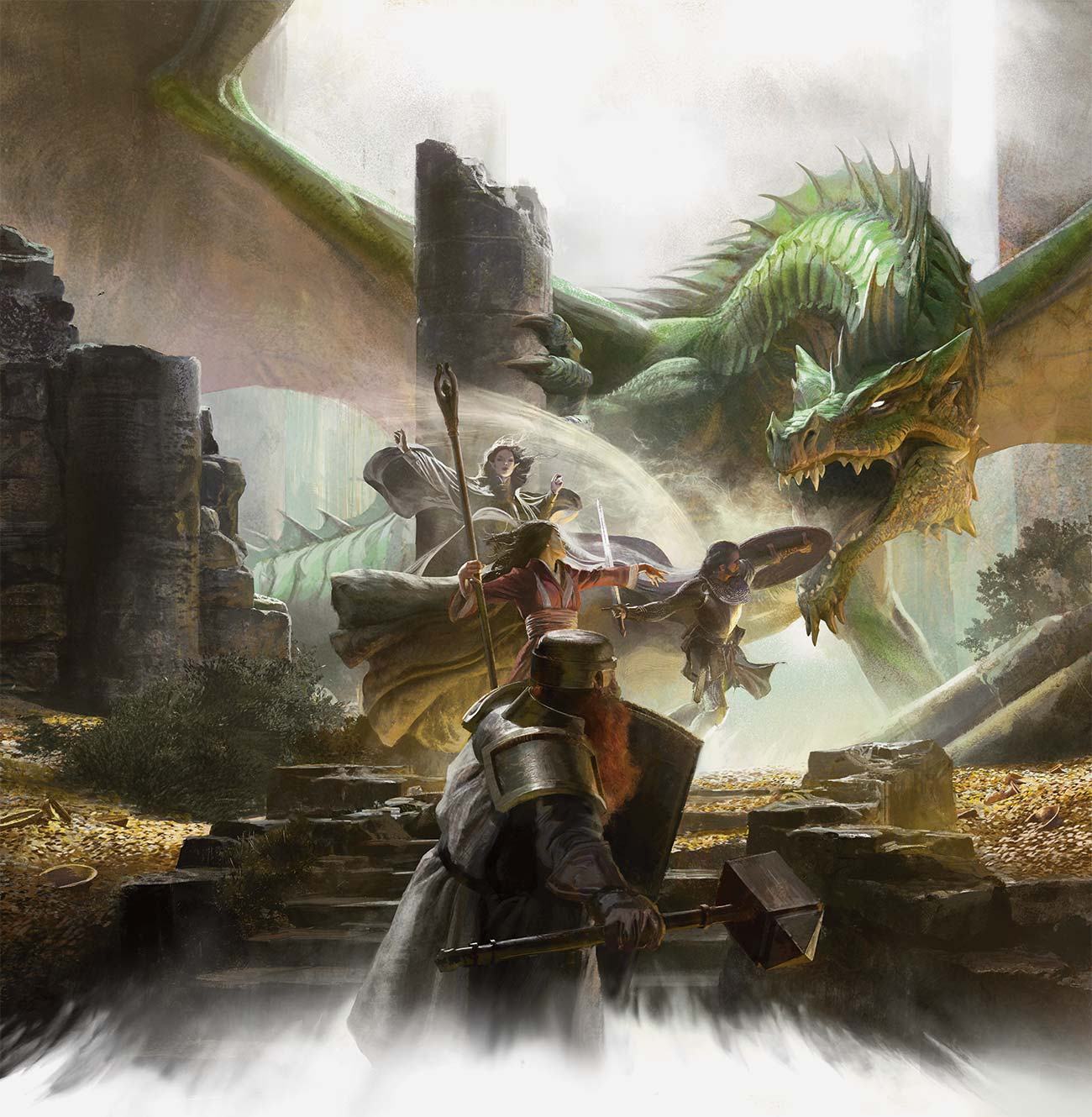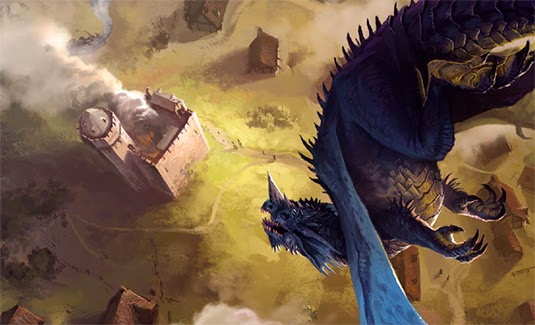Dragons
"One must admire these crafty creatures, because if you do not, say goodbye to your loved ones." - Drig's Monster CompendiumDragons, also called Wryms or Serpents of Old, are a clever and magical reptilian species found roaming all across Talamh. Once being known for their nobility, the creatures have been disgraced and feared because to their hunger for superiority. They are the bitter enemies of Humans.
Basic Information
Anatomy
Dragons are creatures with thick, armor-like scales that cover their body in order to make them resistant to most damage. Often dragons will have horns on the back of their heads and sharp teeth. Becausre they have six appendages, they have wings and find themselves being both quadruped and bipedal due to their frontal arms that have hands used for grasping or crawling. They also have a tail.
Genetics and Reproduction

Draconomicon by Todd Lockwood
Growth Rate & Stages
Wyrmlings, once hatched, will immediately spot their mother and begin to follow her and use her protection. The childhood of a dragon takes about 15 years to complete, where they will start off about a foot in length and grow up to six feet in length. Once the mother deems it mature by a flying and breath test, it will leave it's side and have it go out into the world by itself.
The next five years, called the "Domination Period" is when a young dragon begins to hunt and plunder for itself. It will grow another 4-5 feet in length as it matures into an adult. This is also the period where many dragons go to find their "dungeons" or "lairs" where they will make their permanent home. By the end of this time, they will become adult dragons, and will continue to grow in power and strength unless slain. But in truth, they never stop growing until they die, meaning they can get from the adult size of 20 feet in length to 40.
The time they become ancient is when they hit the mark of 100 years, signifying they have overcome most challengers. This is an age of honor. The next sets of hundred will mark even more honor, and the last hundred is the sign of a well-lived life for a dragon and being worthy of death.
Ecology and Habitats
Dragons enjoy finding old abandoned buildings or fortresses and hording tons of gold for themselves or other treasures. Others often find the ruins in order to be in a place of solitude. Caves also make excellent lairs due to their large size and discreet hiding places for the dragons to rest undisturbed. However, dragons also prefer being around places to hunt for prey and occasionally go near villages to bully humans, dwarves and elves.
Dietary Needs and Habits
Dragons are surprisingly omnivorous despite what the sharp teeth show. They enjoy eating both sheep and other animals, as well as eating large fruit. However, most dragons prefer hunting their food. The harder the hunt, the more satisfying it is for them to eat. In this sense, they do not enjoy meals based on taste but based on the prey's well-earned defeat.
When gathering food, dragons like to store their leftovers in sloven piles and gnaw on it for hours. They will even eat the bones for extra marrow in order to satisfy their nutrients. Often the dragon will cook it's food with it's breath to maximize the amount of calories it intakes so it's strong brain and body can be sustained.
Additional Information
Social Structure
Dragons are creatures of isolation, not enjoying being around each other unless for the sake of courting or raising a wyrmling. This means they will try to be their own master and ruler. Collecting hordes of bones and treasures in their lairs makes it so they can decorate themselves with honor. Occasionally, they will find it reasonable to find a human village so they can harass it for gold and some of the livestock they use.
Despite isolation, there are kings and queens in dragon society. Primarily, the most powerful dragon in a region is usually deemed "king" out of respect, though there is no true submission. They expect submission from humans, and indeed sometimes get it. Kobolds are their draconian cousins, small in stature and strength, which dragons love to use against them. Kobolds get bullied by dragons to doing their bidding, thus fulfilling their superiority complexes. This can also be used against humans and their villages if pushed hard enough.
Civilization and Culture
Naming Traditions
Dragons often add a lot of hard-sounding consonants in their words, primarily Ks and C's and G's. This is due to their vocal cords having them pronounce human languages like Common being harder for them to pronounce. Indeed, draconic gives them a cackling tendency in their accents, and this translates to their names.
Beauty Ideals
In this dragons are simple: admiration is found in dominance and cleverness. Strangely, this can be done by material gain. The choicest of livestock taken, or the greatest of jewels, is what makes a dragon beautiful to each other. Besides material wealth, the length of horns can also be taken as a sign of beauty simply because of how healthy they are.
History
The Beginning
Shortly after the Good Divines had created Talamh and it's inhabitants during the Creation, dragons would be formed from the deep dwellings of the earth by Bahamut and Tiamat. They would get their color from the colorful minerals or the metals deep underneath. The dragons were intended to be helpers of the other races because of their power and craftiness. And in fact the dragons were noble in their ways for 100 years, watching the dwarves and elves and helping them in their efforts. In fact, many of them would be venerated in works by these two sentient beings. However, the dragons would find themselves being challenged by a species just as clever as them: humans. Indeed they would discover beings strangely resembling Amagus. At first the dragons wished to help them, but they found the humans had ingenuity to fend for themselves."These images of Amagus strangely were like the dragons themselves. They were as swift as them in hunting, as terrifying as them in ethics, and as hardy as them in fearlessness. The dragons became fond of them." - The Draconium
The Fall
The dragons would begin to grow jealous of the humans. They were building wonders and social structures that rivaled the dragons. Their land and thrones sprawled across Talamh. One of the red dragons, Kuchall, began to grow jealous of humans along with other chromatic dragons. Then, in a day unmarked but very much remembered, Kuchall murdered a man to prove their dominance. The bloods of Man cried out to the other dragons, terrified of the evil Kuchall had done. However, Kuchall proclaimed to the others that humans were inferior and were prey. The chromatic dragons began to agree with him, but the metallic dragons were disgusted by the display. Thus, the dragons, once unified, became split. Most of the Chromatic dragons would begin to follow the personification of chaos, Tiamat, in order to display further dominance over men. Meanwhile most Metallic dragons stuck with Bahamut, the personification of justice, protecting Humans from their fallen brethren. Future attacks by Chromatics led humans to proclaiming that dragons were their enemy. The dragons, good and evil, would be decimated and driven to isolation as men began to overpower them and establish their kingdoms. Yet not all dragons fell into these factions. One silver metallic dragon, named Gergelek, terrorized the lands of Gothai in the 23rd century when she saw humans unfit for just rule. She would be opposed by other metallic dragons who felt she had gone too far in lawfulness. The green dragon Vlekvokal in Keller became a national symbol for those people when it fought off a small clan of Goliaths attacking them. But these differences would become more and more a rarity.
Scientific Name
Reptilia Draco
Lifespan
Around 600 years
Average Height
If standing on their hind legs, they can reach about 15-18 feet tall. Otherwise, they are usually 7 feet tall due to lifting the neck.
Average Weight
~1000 lbs.
Average Length
20-40 feet
Body Tint, Colouring and Marking
There are two types of dragons for colorings:
- The Chromatic Dragon, which can be found on the ROYGBIV color spectrum, as well as white and black.
- The Metallic Dragons, which are gold, silver, bronze, and copper in color. They have a metal-like sheen to their scales.
Remove these ads. Join the Worldbuilders Guild






Comments